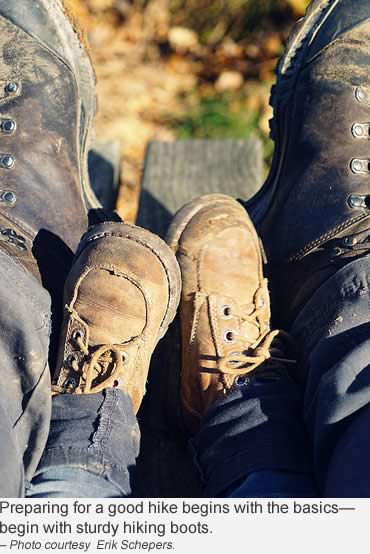No matter where you live, the arrival of fall brings renewed interest in hiking.
Exploring local trails, parks and other recreational opportunities continues to engage people with the outdoors, something important for physical and mental health. As temperatures cool and colorful foliage emerges, there’s a surge in hikers hitting the trails.
It’s fun for people of all ages, which is why planning ahead is the best way to start a hike.
While autumn encourages the nature connection for many, all outdoor recreation requires awareness, preparation and responsibility for yourself and others.
New Hampshire Fish and Game Law Enforcement Chief Colonel Kevin Jordan offers some solid advice to experienced and new hikers in his state’s rugged outdoors.
 “This fall, people hiking must be aware of safe social distancing and their physical limitations,” he said.
“This fall, people hiking must be aware of safe social distancing and their physical limitations,” he said.
“Unpredictable weather, temperature fluctuations, and reduced hours of daylight mean that people must be prepared with flashlights, layers of clothing that will keep the body warm and dry, and most importantly, hikers must know when to turn back. This is not the time for challenging hikes or dangerous backcountry adventures in ever-changing weather conditions.”
Staying safe requires basic information and preparation, no matter if you plan to hike America’s longest loop trail, the 1,444-mile Buckeye Trail in Ohio, or a segment of the massive Appalachian Trail, or spend a few, fun hours at a familiar and nearby state park.
Colonel Jordan recommends hikers be prepared and carry with them the essentials for changeable weather conditions and for unanticipated emergencies: A map, a compass, warm clothing, including sweaters, rain jackets, long pants and a hat, extra food and water, a flashlight or headlamp (check the batteries before you go), matches or a firestarter, a first aid kit, a whistle and a pocket knife.
One item that can literally be a life-saver is a low-weight, low-bulk, heat-reflective space blanket, available almost everywhere hiking gear is sold. Anyone planning a hike should tuck one into their backpack.
 Family or youth group hikers should follow similar guidelines so that everyone on the hike is familiar with the map and trails you plan to travel before beginning. Listen to the weather reports, and be sure to let others know where you plan to hike, and when you plan to return.
Family or youth group hikers should follow similar guidelines so that everyone on the hike is familiar with the map and trails you plan to travel before beginning. Listen to the weather reports, and be sure to let others know where you plan to hike, and when you plan to return.
Always wear appropriate clothing, beginning with closed toed-shoes or boots. Keep your feet dry, too. Wet feet will make hikers uncomfortable. Dress in layers, and take breaks when you tire. Over-exertion can lead to injuries or other health problems, but be prepared should an injury occur. That’s when the first aid kit in your backpack and the whistle will come in handy. Many survival whistles often also have a built-in thermometer and compass.
Wearing brightly colored clothing (and never camo) is nearly as good an idea as always staying on marked trail, not climbing around waterfalls, and what to do if you get lost.
Teach young hikers who might become separated from your group to stop. STOP: Stop. Think. Observe. Plan. Staying in one place is the fastest was for a disoriented hiker to be found by other hikers in the group.
A full complement of safety tips for hiking with kids can be found on the Your Hike Guide website. To read about how to plan a summer hike or a group hike and nearly everything between, as well as how to acquire the New Hampshire Hike Safe card, visit the New Hampshire website.
Resources: New Hampshire Department of Fish and Game, Hike Guide.